Both carbon buyers and landowners alike have many questions about how soil carbon storage works. Despite the complexities of the natural process, for people, it’s very simple: we stand back and let nature work as intended.
HOW DOES SOIL CARBON STORAGE WORK?
Soil carbon storage is a natural process where photosynthesis pulls carbon out of the atmosphere and into healthy soil. Prairie plants absorb carbon dioxide and draw the carbon deep down into their root systems in the soil. The healthier the soil, the healthier the plant life with more biodiversity, which leads to more carbon sequestration.
This process is also called soil carbon capture and storage (or soil CCS), soil carbon sequestration, or soil decarbonization.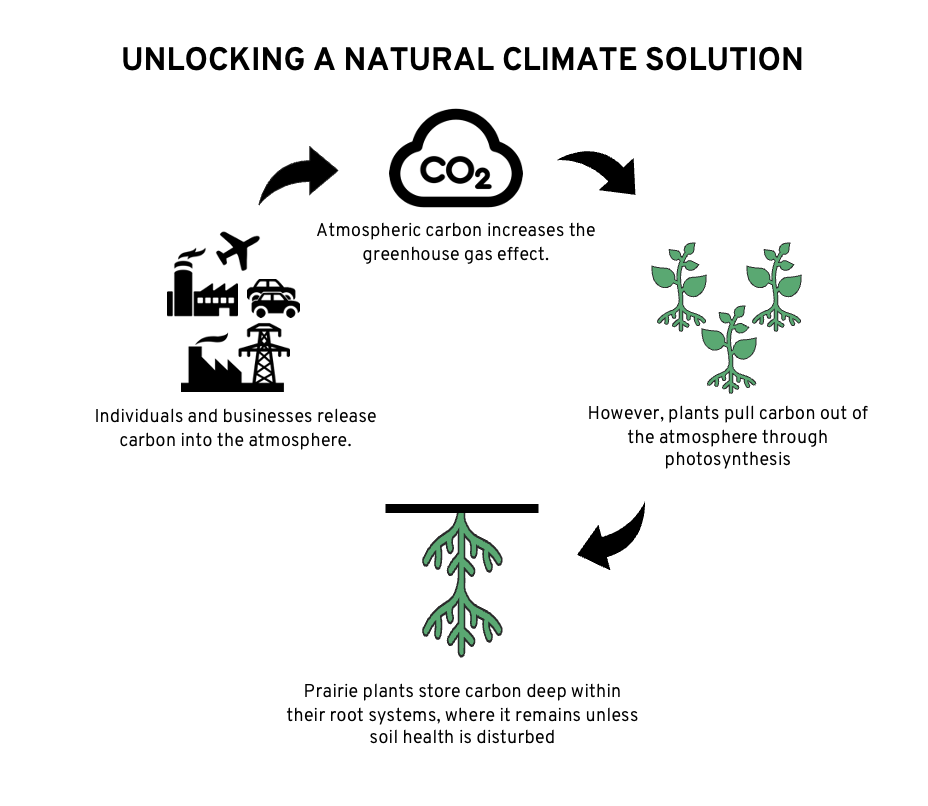
WHAT IS THE ROLE OF HUMANS IN SOIL CARBON SEQUESTRATION?
People, specifically farmers and ranchers, can play a major role in soil carbon capture and sequestration through regenerative agriculture practices. Regenerative agriculture practices are a return to the natural way that land was managed (or perhaps more accurately, not managed) prior to human interference. By mimicking the way that bison grazed on an open prairie, land managers can restore the native ecosystem on their land, stimulating the increased growth of native prairie grasses.
The key to unlocking the nature-based carbon capture solution that is soil carbon storage is bringing prairie grasses back to health. These deep-rooted plants capture and store atmospheric CO2 and transfer it deep into the soil, where it securely remains so long as it is not tilled.
HOW IS REGENERATIVE AGRICULTURE ANY DIFFERENT THAN NORMAL, MODERN AGRICULTURE?
Regenerative agriculture mimics wild herd migration patterns through a process called adaptive multi-paddock grazing. Land managers use livestock, which include bison, cows, goats, and sheep, as tools in this process. These animals are rotated frequently through pastures, which gives the plants time to “rest” between grazing periods. By letting the plants rest, it keeps the animals from being able to graze on a single plant to the point of destruction. During these rest periods, plants return to full health. The restoration of these healthy plants ensures that the land remains covered with plant life, which ensures carbon capture and drawdown, but also promotes biodiversity, improved water retention, erosion mitigation, and supports wildlife.
Ranchers who manage their herds through adaptive multi-paddock grazing rotate their livestock frequently – sometimes as often as multiple times a day. Although it may sound like much more work than traditional ranching practices of letting herds roam over a large property, the cattle learn that a fresh pasture means fresh grass and will move eagerly into the new pasture. One of our participating ranches can move a herd of approximately 8,000 head of cattle from one pasture to another within twenty minutes using a team of only two people and a dog.
I HEAR A LOT ABOUT METHANE EMISSIONS FROM COWS. AREN’T COWS BAD FOR THE ENVIRONMENT?
A common phrase in regenerative agriculture is “it’s not the cow, but how” (i.e. it’s not that cows are necessarily bad for the environment – it’s all about how they are managed). These regenerative practices ensure that cattle graze on healthy grass, as nature intended. Simply switching cows to this natural grass-fed diet drastically reduces their methane emissions. Furthermore, land managers do not need to use synthetic fertilizers when deploying adaptive multi-paddock grazing because the manure and urine from the cattle acts as natural fertilizers and the plants are not grazed to destruction.
As such, cows can be very good for the environment when regenerative agriculture practices are deployed. By supporting regenerative agriculture, one can see emissions reductions in several areas:
- Carbon drawdown and sequestration through soil carbon capture as a result of restoring native grasslands;
- Reduced emissions from cows as a result of a grass-fed diet;
- Eliminated feedstock needs, reducing the emissions and destructive practices associated with modern agriculture and the transportation of those feedstocks; and
- Eliminated synthetic fertilizer needs, reducing the emissions of producing and transporting the fertilizers.
OK, COWS CAN BE GOOD FOR THE ENVIRONMENT, BUT I STILL DON’T FULLY UNDERSTAND – HOW DO YOU TRANSPORT AND PUMP THE CARBON INTO THE GROUND?
The beauty of a nature-based solution is that we are just supporting nature in working as intended. There are no carbon pipelines, tools, etc. Carbon is sequestered through the natural process of photosynthesis. Plants capture carbon and transport it deep down into their root systems in the soil, where the carbon is stored securely unless the soil health is disturbed.
I UNDERSTAND NOW HOW SOIL CARBON STORAGE WORKS, BUT WHAT IS THE ROLE OF GRASSROOTS CARBON?
Grassroots Carbon serves as an assembler, bringing together many parties: regenerative landowners, carbon buyers, measurement and verification entities. Although this process seems simple, it is very time-consuming.
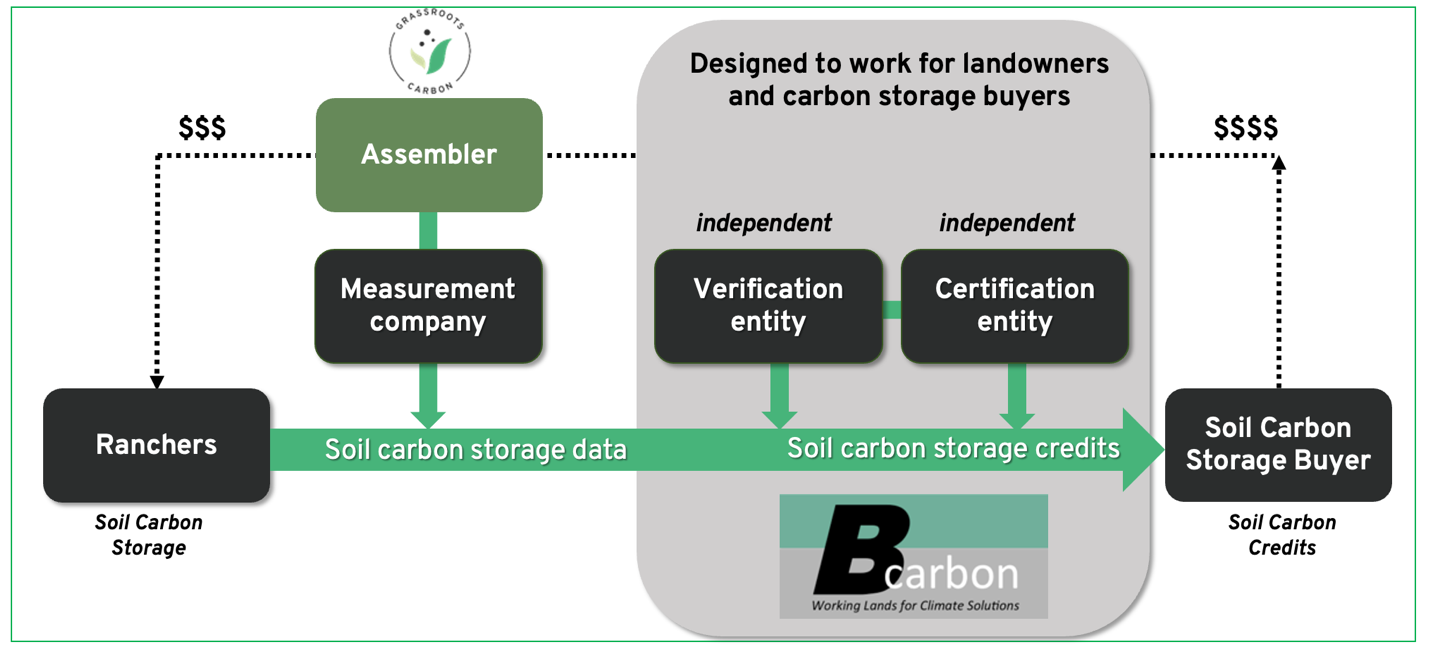
Grassroots Carbon is more than a middle-man – we actively partner with all parties involved to ensure transparency in the process, fair payments to landowners, and verified storage for carbon buyers. For a carbon buyer to work directly with a variety of landowners (like Grassroots Carbon does), they would have to set up an entire division just to handle the management of a soil carbon storage project. Accordingly, Grassroots Carbon provides landowners with secure buyers for their soil carbon storage that they would not otherwise be able to obtain. Through our profit-sharing model, Grassroots Carbon also ensures that landowners benefit from any benefits that we see, whether it’s a reduction in costs or an increase in carbon prices.
For carbon buyers, Grassroots Carbon offers quick access to a large network of regeneratively managed land. Grassroots Carbon ensures that carbon buyers receive measured and verified soil carbon storage credits by bringing in third party validation and certification entities and by working closely with land managers to support best practices. Additionally, Grassroots Carbon actively works to build education and awareness of regenerative practices, ensuring that there is a growing pool of land managers who are actively working to improve their soil health and sequester carbon. Carbon buyers can be confident that soil carbon storage purchased through Grassroots Carbon meet their goals of measured storage, permanence, additionality, and additional ecological and social benefits.
IF A COMPANY BUYS SOIL CARBON STORAGE FROM GRASSROOTS CARBON, IS THERE ANY INCENTIVE FOR THEM TO REDUCE THEIR EMISSIONS? HOW DO YOU PREVENT COMPANIES FROM GREENWASHING?
Soil carbon storage is not intended to be a substitute for a company reducing its own direct emissions. Rather, soil carbon storage is a supplement to direct emission reductions, often as part of a company’s overall climate change and sustainability strategy. Companies in carbon-intensive industries like shipping, aviation, and energy can not reduce their emissions to zero by utilizing even the most stringent emission control technologies and efficiency programs. After reducing their emissions as far as is practicable, many of these companies choose to purchase carbon offsets or carbon removal in order to address their residual emissions. In some cases companies go even further and choose to negate their customers’ emissions or historical emissions using soil carbon storage. Grassroots Carbon enjoys working with companies who are including soil carbon storage in their portfolio of carbon removal technologies. One of our customers, Shopify, has developed a Carbon Removal Playbook to help other companies learn from their efforts to use soil carbon storage as one option within a portfolio of solutions.
One factor behind some greenwashing claims is the fact that many traditional carbon offsets are for avoiding emissions, based on hypothetical scenarios of what might have happened in the absence of the offset project. Grassroots Carbon does not offer avoidance offsets. Instead, we provide real, independently certified soil carbon storage backed by actual soil measurements.
NOW THAT I UNDERSTAND ABOUT SOIL CARBON STORAGE, HOW CAN I SELL MY STORAGE AS A LANDOWNER OR HOW CAN I PURCHASE SOIL CARBON CREDITS AS A CARBON BUYER?
If you are interested in selling your soil carbon storage, please contact us here: https://buildgrassroots.com/ranchers/#getInTouch
If you are interested in purchasing soil carbon storage credits, please contact us here: https://buildgrassroots.com/carbon-buyers/#getInTouch
- SEO Powered Content & PR Distribution. Get Amplified Today.
- Platoblockchain. Web3 Metaverse Intelligence. Knowledge Amplified. Access Here.
- Source: https://buildgrassroots.com/how-soil-carbon-storage-works/
- 000
- a
- Able
- About
- access
- accordingly
- accurately
- actively
- acts
- Additional
- Additionally
- address
- After
- agriculture
- All
- Although
- and
- animals
- Another
- approximately
- areas
- associated
- Atmosphere
- atmospheric
- automatically
- aviation
- avoiding
- awareness
- back
- backed
- Bad
- based
- Beauty
- because
- behind
- being
- benefit
- benefits
- BEST
- best practices
- between
- Bringing
- build
- buyers
- Buys
- called
- capture
- carbon
- carbon credits
- carbon dioxide
- cases
- Certification
- Certified
- change
- Choose
- claims
- Climate
- Climate change
- closely
- Common
- Companies
- company
- Company’s
- complexities
- confident
- contact
- control
- Costs
- covered
- Credits
- Customers
- day
- decarbonization
- deep
- deployed
- deploying
- description
- Despite
- developed
- Diet
- different
- direct
- directly
- Division
- Dog
- Dont
- down
- drastically
- during
- Ecological
- ecosystem
- Education
- efficiency
- efforts
- emission
- Emissions
- energy
- ensure
- ensures
- ensuring
- Entire
- entities
- Environment
- etc
- Even
- fair
- farmers
- frequently
- fresh
- from
- full
- fully
- further
- Furthermore
- generated
- gives
- Go
- Goals
- good
- grassroots
- Ground
- Growing
- Growth
- handle
- happened
- head
- Health
- healthier
- healthy
- help
- here
- historical
- How
- HTTPS
- human
- Humans
- improve
- improved
- in
- Incentive
- include
- Including
- Increase
- increased
- independently
- industries
- instead
- interested
- involved
- IT
- Key
- Land
- landowners
- large
- Leads
- LEARN
- letting
- Life
- Long
- Lot
- major
- manage
- managed
- management
- Managers
- many
- means
- measurements
- Meet
- methane
- methane emissions
- might
- migration
- minutes
- mitigation
- model
- Modern
- more
- most
- move
- multiple
- native
- Natural
- Nature
- necessarily
- Need
- needs
- network
- New
- normal
- offer
- Offers
- offset
- ONE
- open
- Option
- order
- Other
- otherwise
- overall
- own
- part
- participating
- parties
- partner
- party
- patterns
- payments
- People
- perhaps
- periods
- Photosynthesis
- plants
- plato
- Plato Data Intelligence
- PlatoData
- Play
- please
- Point
- pool
- portfolio
- practices
- prevent
- Prices
- Prior
- process
- Programs
- project
- promotes
- property
- provides
- Pulls
- pump
- purchase
- purchased
- purchasing
- Questions
- Quick
- real
- receive
- reduce
- reduces
- reducing
- regenerative
- remains
- removal
- REST
- restoration
- restoring
- result
- retention
- return
- Role
- root
- scenarios
- secure
- securely
- seems
- sell
- Selling
- sequestration
- serves
- set
- several
- sheep
- Shipping
- Simple
- simply
- single
- So
- Social
- solution
- Solutions
- some
- Sound
- specifically
- stand
- Still
- storage
- store
- stored
- Strategy
- such
- support
- Supporting
- Supports
- Sustainability
- synthetic
- Systems
- team
- Technologies
- The
- their
- Third
- Through
- time
- time-consuming
- timeline
- times
- to
- together
- tools
- traditional
- transfer
- Transparency
- transport
- transportation
- understand
- unlocking
- us
- use
- Utilizing
- validation
- variety
- Verification
- verified
- Water
- What
- What is
- whether
- which
- WHO
- Wild
- will
- within
- Work
- working
- works
- would
- Your
- zephyrnet
- zero


![How Nature Captures and Stores Carbon [Webinar]](https://platoaistream.com/wp-content/uploads/2022/12/how-nature-captures-and-stores-carbon-webinar.jpg)
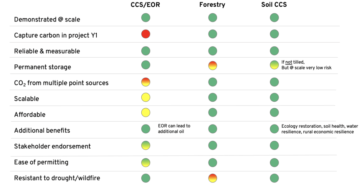
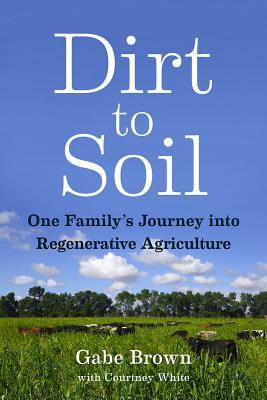
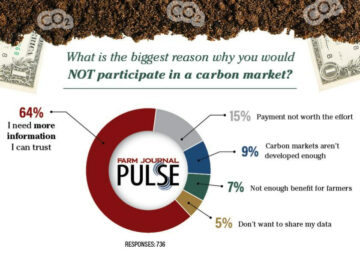
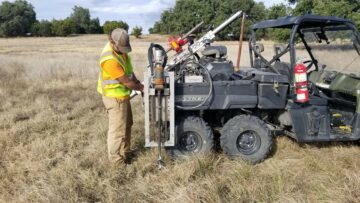



![Grassroots Carbon Presents: “Soil Carbon Permanence, an Introductory Discussion” Featuring special guest Dr. Jocelyn Lavallee [Webinar]](https://platoaistream.com/wp-content/uploads/2022/12/grassroots-carbon-presents-soil-carbon-permanence-an-introductory-discussion-featuring-special-guest-dr-jocelyn-lavallee-webinar-360x240.jpg)